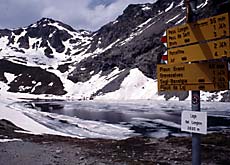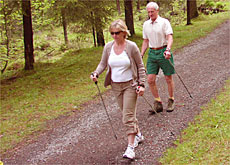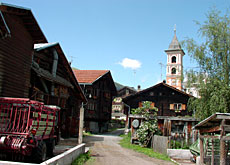Via Alpina brings sustainable tourism to the Alps

Consisting of 5,000 kilometres of trails, the Via Alpina is the first hiking network to connect the whole Alpine region, from Monaco to Trieste.
The Swiss section of the project, which aims to contribute to the development of sustainable tourism in the Alps, opened on August 1.
The Via Alpina initiative was launched five years ago by France’s “La Grande Traversée des Alpes” association, a body set up to promote hiking in the French Alps.
It is supported by the European Union and the eight member countries of the Permanent Committee of the Alpine Convention, and has a five-year budget of €4 million (SFr6.2 million).
“The purpose of the project is to help mountain regions exploit their landscape and cultural resources in a sustainable way,” explained Marcel Grandjean, the Swiss project leader.
The trails have been planned to serve less well-known regions, off the main tourist routes.
Many stages
The main trunk of the Via Alpina – the red trail – wends its way through France, Italy, Switzerland, Liechtenstein, Austria, Germany and Slovenia, linking Monaco to Trieste. It is 2,400km long and breaks down into 161 separate stages.
Branching off from this main trunk are four subsidiary routes: the blue trail, running through France, Italy and Switzerland; the green trail, between Liechtenstein and the Bernese Oberland; the yellow trail, connecting Bavaria to Trieste via the Dolomites; and the purple trail, running through Bavaria, Styria, Carinthia and Slovenia.
The Grande Traversée des Alpes is in charge of international coordination, but national and local organisations are responsible for practical implementation.
“It is a good example of how to promote a socially and ecologically compatible form of tourism with a decentralised structure, but which embraces the whole Alpine region,” explained Werner Bätzing, professor of geography at Erlangen-Nuremburg University and an expert on Alpine matters.
Waymarking and guide books
During the first phase, which ends in the autumn of 2004, the five trails will be waymarked with the Via Alpina logo or small information boards.
The routes follow existing paths and therefore it has not been necessary, except in very few cases, to lay out new sections.
In Germany, Austria, Liechtenstein and Monaco, waymarking has already been completed; in Switzerland, Italy and Slovenia, work is still in progress.
Technical information about the trails, including overnight accommodation arrangements, will be posted on the Via Alpina website over the next few months.
There are also plans to publish guidebooks, giving information about the surrounding areas, as well as facts and figures about the trails themselves.
“Six volumes – in Italian, German, French and English – are being prepared by specialist publishing houses and should come out in 2005,” said Nathalie Morelle, European co-ordinator of the Via Alpina project.
Meanwhile, Bavaria has stolen a march on the other regions, publishing its own guide last year.
Developing tourism
During the second phase (2005-2007), for which an application for EU funding has just been submitted, the plan is to develop tourism facilities related specifically to the Via Alpina, in conjunction with local tourism authorities.
Tourists will eventually be able to make bookings to hike along the Via Alpina, including overnight accommodation and excursions.
“This service will be geared to tourists with no experience of organising long-distance Alpine treks,” said Morelle.
A pilot project has been started in canton Graubünden, where the trails have already been waymarked. The Swiss section of the network will be inaugurated in the canton’s Poschiavo valley on August 1.
An Alpine identity
The development of the Via Alpina, which is the first network of trails to cover the whole of the Alps, comes at a time of growing debate on Alpine identity and the role of the Alps in the new Europe.
Since 1945, the Alpine region has had to reconsider its identity in an era of increasingly permeable national borders.
“This new interest in the Alps as a single area is a post-war phenomenon – a phenomenon connected with two movements: European integration and regionalism,” said Jon Mathieu, director of the Lugano Institute of Alpine History.
According to Mathieu, hiking on the Via Alpina trails is therefore also a way of (re)discovering the Alps as a shared environment, even though it is also a region of significant cultural, linguistic and physical differences.
“I believe that many people want to be able to appreciate the differences in Alpine cultures,” he added.
“It would be boring if you always came across the same things as you hiked along.”
swissinfo, Andrea Tognina
5,000km of trails.
950km in Switzerland.
5 routes.
2001-2006 budget: €4 million in two phases.
The five Via Alpina trails, which follow existing paths, run through many areas of great cultural and natural interest, including a number of nature reserves.
They follow ancient, high-altitude routes, passing close to some of the best-known Alpine towns and crossing national borders more than 60 times.

In compliance with the JTI standards
More: SWI swissinfo.ch certified by the Journalism Trust Initiative


You can find an overview of ongoing debates with our journalists here . Please join us!
If you want to start a conversation about a topic raised in this article or want to report factual errors, email us at english@swissinfo.ch.